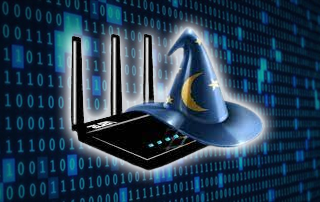
The following tutorial will show you how to install a VPN on Asus-Merlin Router.
We provide both a screenshot guide as well as a video guide to help you walk through this process.
Installing a VPN on a router allows you to “set it and forget it.” This allows you to protect devices like Roku, gaming systems, and other internet-connected devices that don’t support VPN apps.
The nice part about using “policy-based routing” on Asus-Merlin firmware is that we can define which devices on our network should be protected by a VPN and which ones shouldn’t.
Asus-Merlin Firmware (Asuswrt-Merlin) is a third-party firmware that provides users the ability to set up and use various VPN features that will help protect their online privacy.

Important Note: If you don’t already have Asus-Merin firmware installed on your router, you can visit the tutorial below.
How to Install Asus-Merlin Firmware on Router
In this guide, we are using an Asus GT-AX11000. However, this will also work for tons of other models of Asus routers as well.
In this example, we will be installing IPVanish VPN on our Asus-Merlin router. Most popular VPNs will support this type of setup.
We suggest watching our video guide which provides important details that are not available within the screenshot guide.
How to Install VPN on Asus-Merlin Router with Policy-Based Routing
Video Tutorial
Important Links:
How to Install Asus-Merlin Firmware on Router
How to Restore Asus-Merlin Router Firmware
Screenshot Guide
Follow the screenshots below for installing a VPN on an Asus-Merlin router.
1. The first thing I’m going to do is log into my Asus-Merlin dashboard.
Most of you should be able to log in by visiting router.asus.com. The reason I can’t do this is because I’m running this as a second Asus router on my network.

2. If you’re like me and yours isn’t loading with that address, click the search bar and type in “cmd” for command.

3. Then type in “ipconfig” and hit enter.
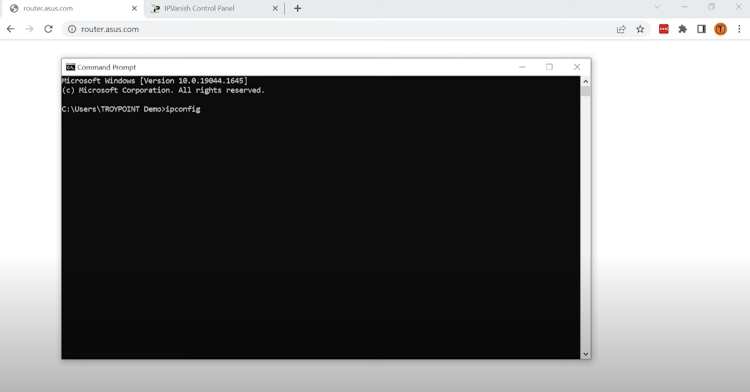
4. Then locate your Default Gateway address. Save this for the next step.
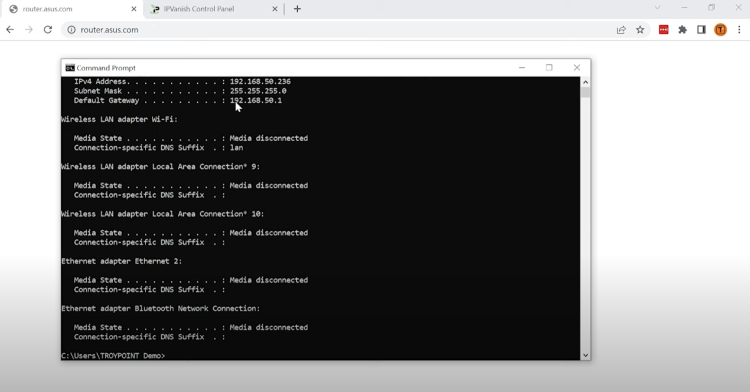
5. Type that Default Gateway address into the address bar. Then enter your login credentials for the Asus-Merlin firmware and click Sign In.

6. We are now logged in to our Asus-Merlin router admin panel.

7. Prior to installing a VPN on Asus-Merlin, there are a few items to point out. First click LAN.

8. We suggest making sure your LAN IP Address is different than the IP Address on your main router. You can simply change the last three digits if necessary.

9. Next click DHCP-Server.

10. Scroll down and you will notice that DNS Server 1 and DNS Server 2 are completely blank. Leave these blank.

11. Then click Wireless on the left menu.

12. Under Band make sure you set up a network name for each of these.

13. You will want to set a login password for WPA Pre-Shared Key. Then click Apply.

14. Next click the VPN option on the left menu.

15. Click VPN Client.

16. Now we want to import two important files into the VPN client tab.
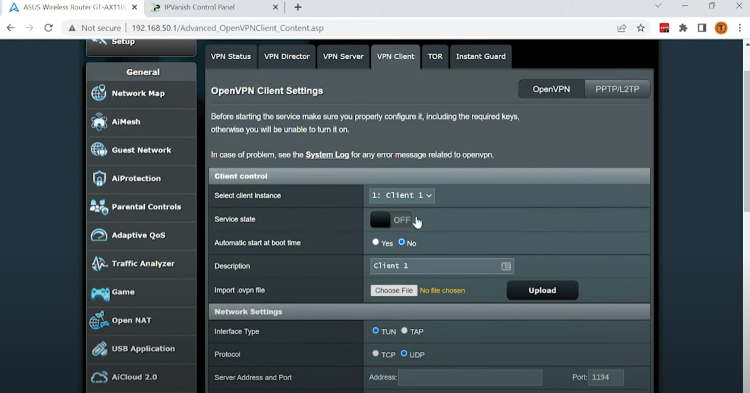
17. As mentioned earlier, we are using IPVanish VPN which works great with this process.
In another tab, I am logged in to my IPVanish account dashboard.

18. Click Server List

19. Now on the left side click OpenVPN under ALL OS.
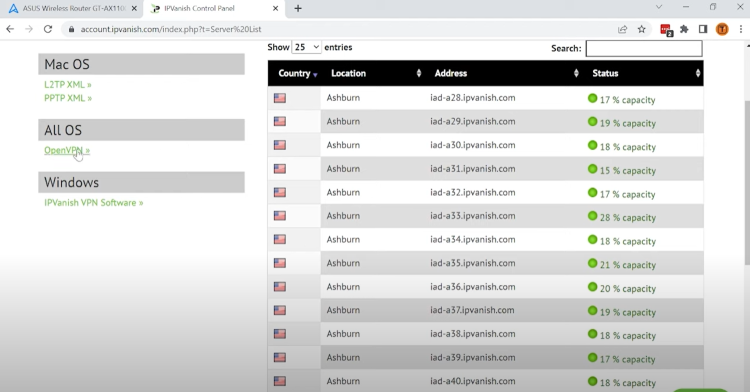
20. This is going to download all the configuration files. Click Show in folder.

21. Right click the configs zip file and then click Extract All.

22. Click Extract.
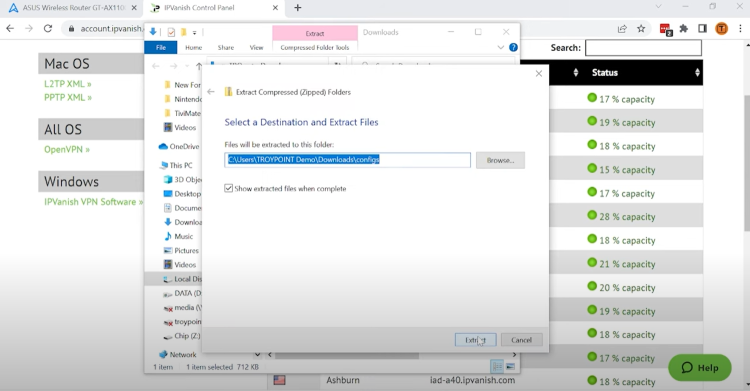
23. Wait a minute or two for the zip folder to extract.

24. You will find all of the ovpn files for every server that IPVanish offers. We also have our certificate.

25. Then exit out of the folders and return back to the IPVanish server list page.
We searched for Chicago in this example and filtered by the lowest capacity.
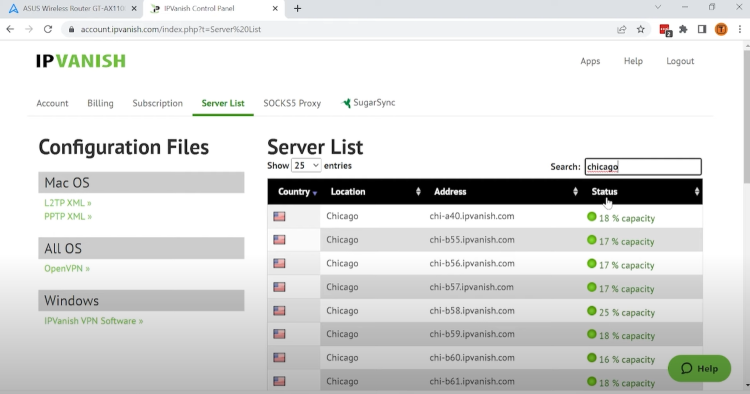
26. Once you have determined the IPVanish server you want to use, return back to the Asus-Merlin dashboard.
Click Choose File next to the “Import .ovpn file.”

27. Locate your configs folder and click that.

28. Locate the IPVanish server you want to import and click that option.
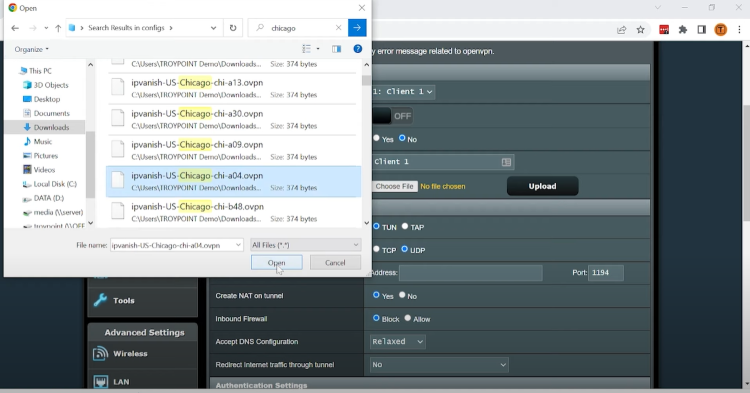
29. Click Upload.

30. Click OK when this message appears.
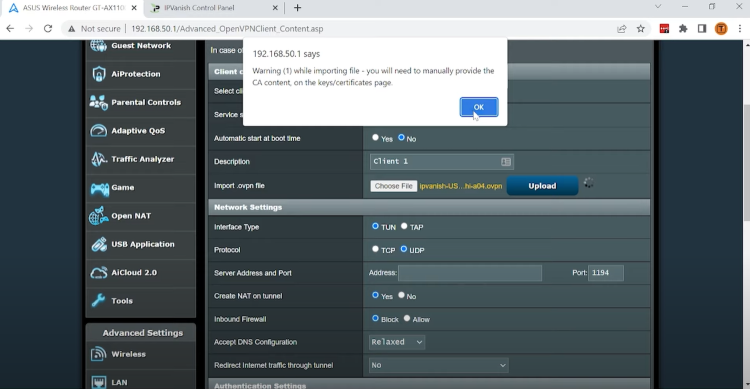
31. Next we need to add the certificate. Find your configs folder again and click to open it.

32. Right-click the certificate file, click Open with, and then choose Notepad or any text editor.
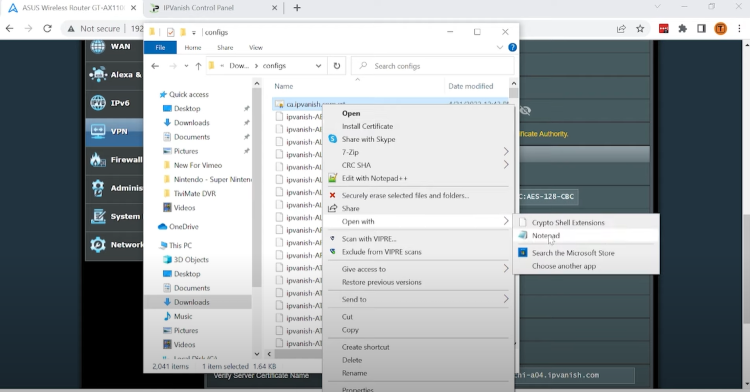
33. Copy everything on this screen.

34. Then click Edit next to Keys and Certificates.
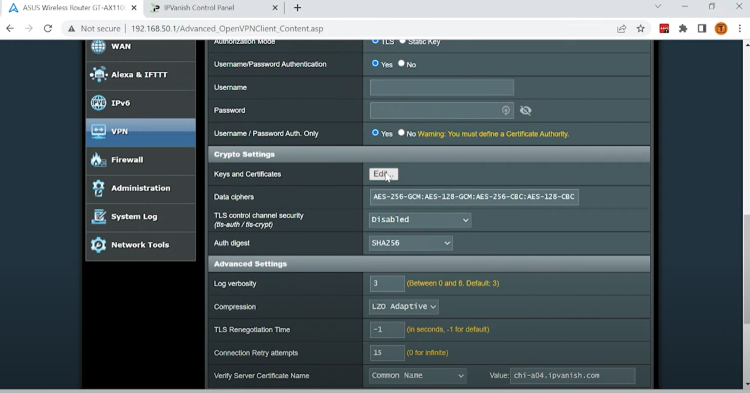
35. Then paste the certificate text into the Certificate Authority box.

36. Click Save.

37. Now type in your username and password for IPVanish VPN under Authentication Settings.

38. Scroll down and click Apply.
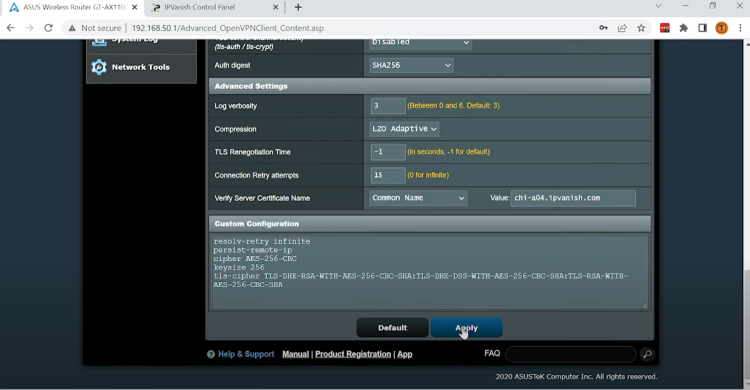
39. Now I can start going through and changing some of these different settings.
First, set up your first client. In this instance, we renamed it to “IPVanish Chicago.”

40. Change Accept DNS Configuration to Exclusive.

41. Change Redirect Internet traffic through the tunnel to Yes (all).
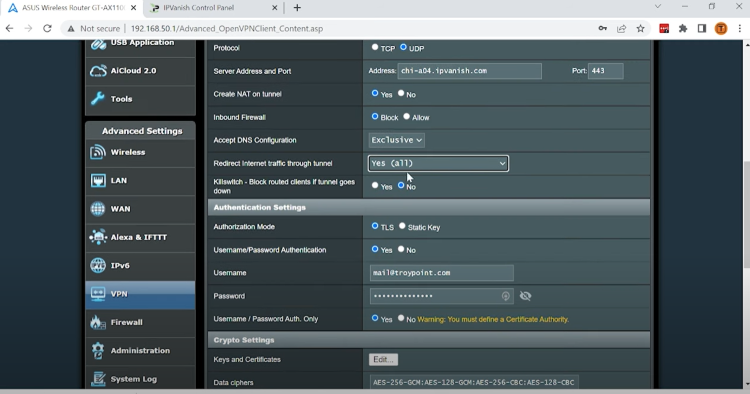
42. Make sure you choose Yes for the killswitch.

43. Then click Apply.

44. Then make sure Automatic start at boot time is checked to Yes.
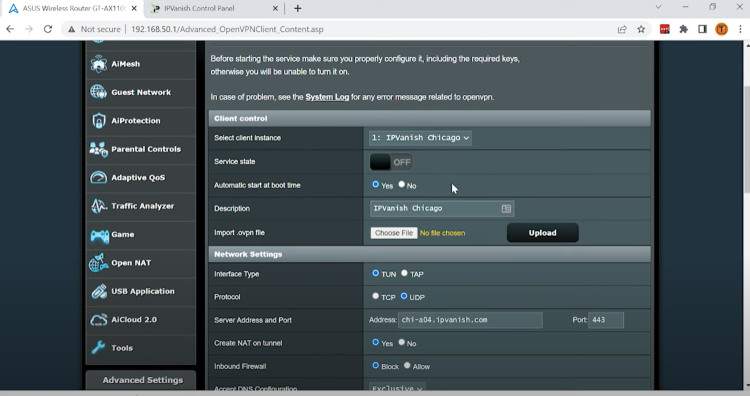
45. Click Apply again.
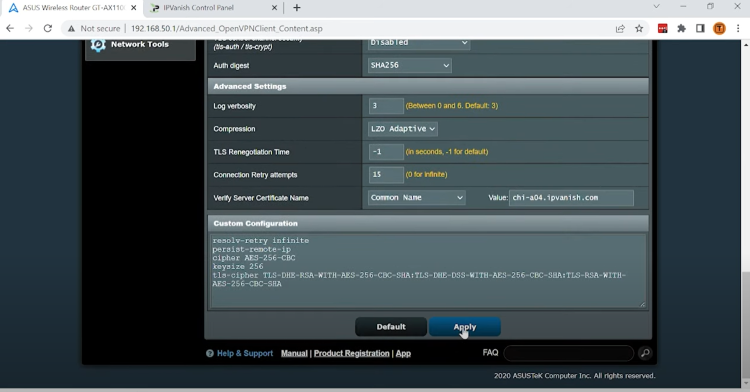
46. Next turn ON the Service state. The VPN should now be active.

47. You can check VPN Status by visiting dnsleaktest.com and your IP address will be different.

48. You can even click the Extended test feature and you will notice there is no private information regarding my location.

49. Now I’m going to double-check my VPN connection status on another internet-connected device. In this case I’m using the Amazon Firestick.

50. Hover over the Settings icon and click Network.

51. You should notice your VPN Wi-Fi hotspot coming from the router.

52. Go back to the home screen and launch Analiti Speed Test and you will notice we are getting excellent speeds!

53. Now return back to the computer and we will show how to use policy-based routing. Click the VPN Client tab.
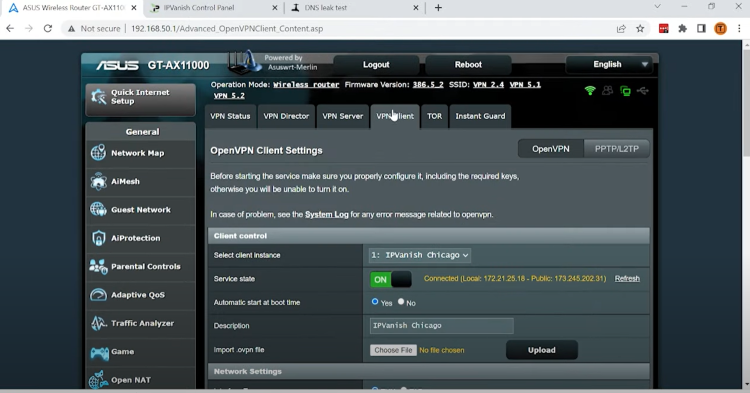
54. For the Redirect Internet traffic through tunnel, change that option to VPN Director (policy rules).
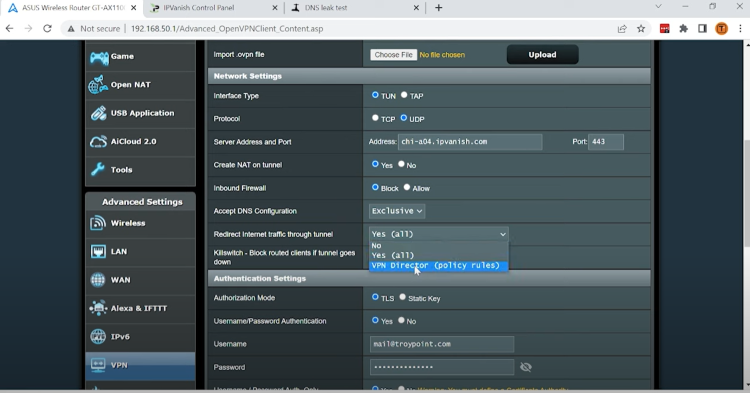
55. Then click Apply.
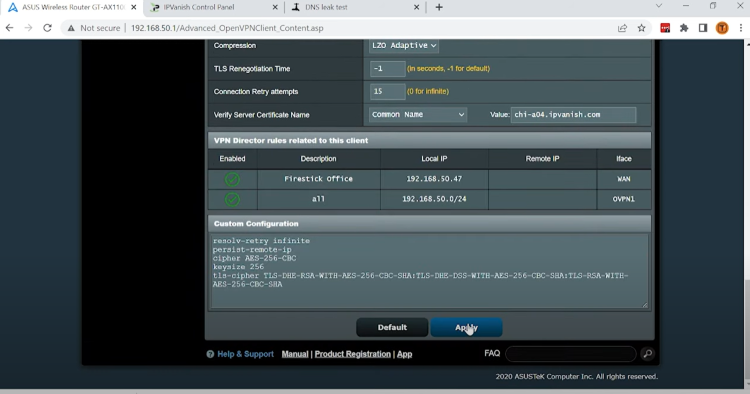
56. Click the VPN Director tab.

57. Choose LAN on the left menu.

58. Click DHCP-Server.
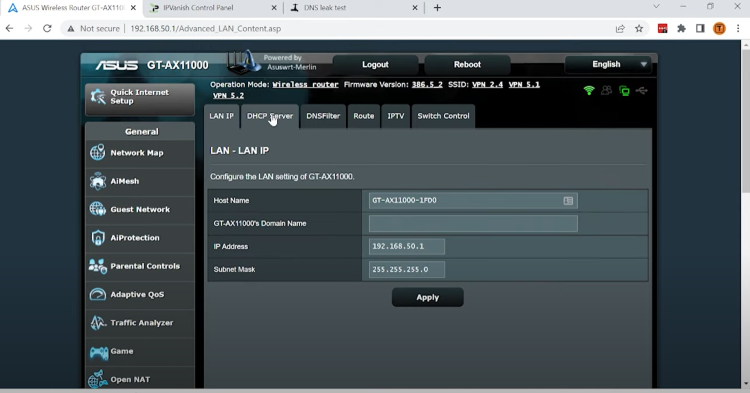
59. Then click the down arrow and you will notice your devices connected to the router. Choose your device.

60. Click the plus button.
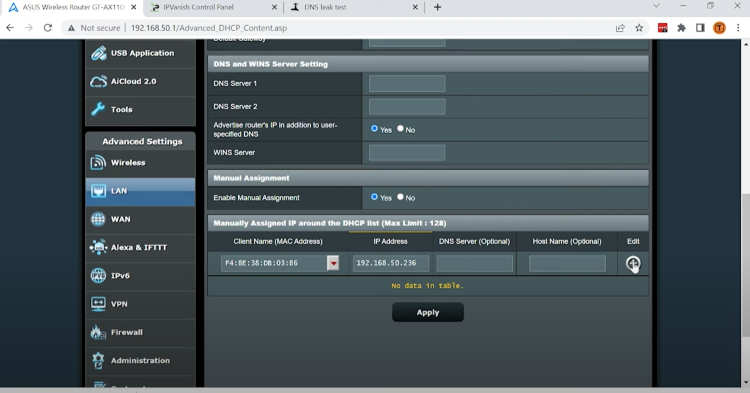
61. Also add your other devices and click Apply.
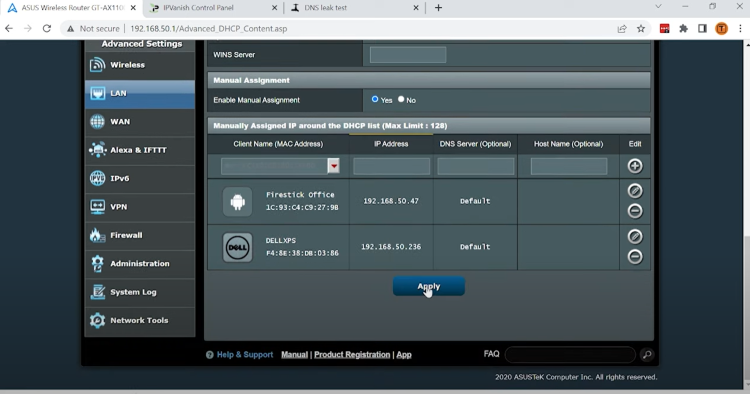
62. Then click VPN on the left menu.

63. Click the VPN Director tab.

64. Now to add any devices you want to protect with the VPN, click the plus button.

65. Choose the IPVanish Chicago for the interface, click your protected device for Local IP and click OK.

66. Click Apply.
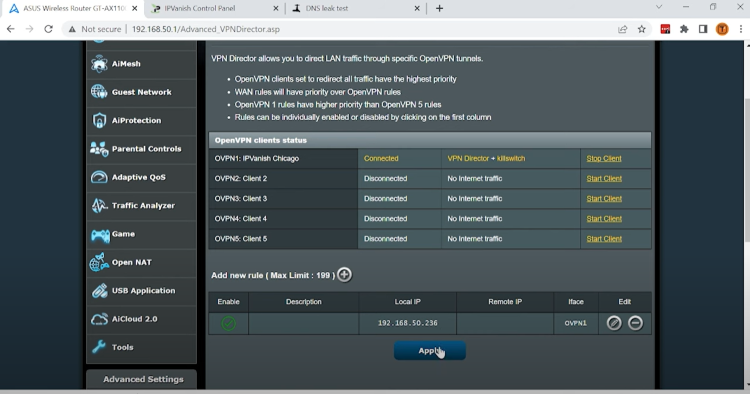
67. Simply repeat the same process for any other devices you want to protect. Then click Apply.

That’s it! You have successfully installed a VPN on an Asus-Merlin router. Enjoy!
0 Commentaires